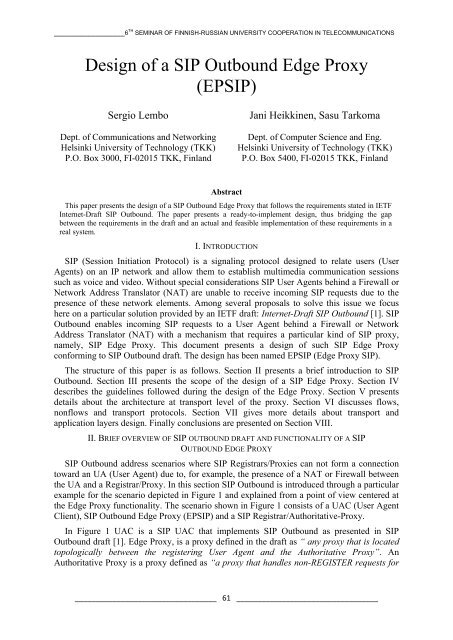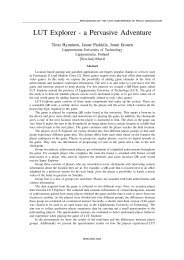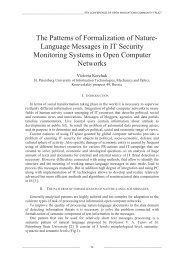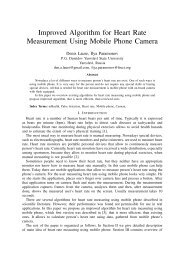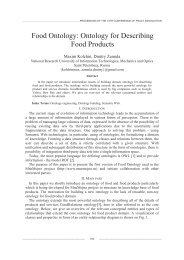Design of a SIP Outbound Edge Proxy (EPSIP) - FRUCT
Design of a SIP Outbound Edge Proxy (EPSIP) - FRUCT
Design of a SIP Outbound Edge Proxy (EPSIP) - FRUCT
Create successful ePaper yourself
Turn your PDF publications into a flip-book with our unique Google optimized e-Paper software.
_________________6 TH SEMINAR OF FINNISH-RUSSIAN UNIVERSITY COOPERATION IN TELECOMMUNICATIONS<br />
<strong>Design</strong> <strong>of</strong> a <strong>SIP</strong> <strong>Outbound</strong> <strong>Edge</strong> <strong>Proxy</strong><br />
(EP<strong>SIP</strong>)<br />
Sergio Lembo Jani Heikkinen, Sasu Tarkoma<br />
Dept. <strong>of</strong> Communications and Networking<br />
Helsinki University <strong>of</strong> Technology (TKK)<br />
P.O. Box 3000, FI-02015 TKK, Finland<br />
Dept. <strong>of</strong> Computer Science and Eng.<br />
Helsinki University <strong>of</strong> Technology (TKK)<br />
P.O. Box 5400, FI-02015 TKK, Finland<br />
Abstract<br />
This paper presents the design <strong>of</strong> a <strong>SIP</strong> <strong>Outbound</strong> <strong>Edge</strong> <strong>Proxy</strong> that follows the requirements stated in IETF<br />
Internet-Draft <strong>SIP</strong> <strong>Outbound</strong>. The paper presents a ready-to-implement design, thus bridging the gap<br />
between the requirements in the draft and an actual and feasible implementation <strong>of</strong> these requirements in a<br />
real system.<br />
I. INTRODUCTION<br />
<strong>SIP</strong> (Session Initiation Protocol) is a signaling protocol designed to relate users (User<br />
Agents) on an IP network and allow them to establish multimedia communication sessions<br />
such as voice and video. Without special considerations <strong>SIP</strong> User Agents behind a Firewall or<br />
Network Address Translator (NAT) are unable to receive incoming <strong>SIP</strong> requests due to the<br />
presence <strong>of</strong> these network elements. Among several proposals to solve this issue we focus<br />
here on a particular solution provided by an IETF draft: Internet-Draft <strong>SIP</strong> <strong>Outbound</strong> [1]. <strong>SIP</strong><br />
<strong>Outbound</strong> enables incoming <strong>SIP</strong> requests to a User Agent behind a Firewall or Network<br />
Address Translator (NAT) with a mechanism that requires a particular kind <strong>of</strong> <strong>SIP</strong> proxy,<br />
namely, <strong>SIP</strong> <strong>Edge</strong> <strong>Proxy</strong>. This document presents a design <strong>of</strong> such <strong>SIP</strong> <strong>Edge</strong> <strong>Proxy</strong><br />
conforming to <strong>SIP</strong> <strong>Outbound</strong> draft. The design has been named EP<strong>SIP</strong> (<strong>Edge</strong> <strong>Proxy</strong> <strong>SIP</strong>).<br />
The structure <strong>of</strong> this paper is as follows. Section II presents a brief introduction to <strong>SIP</strong><br />
<strong>Outbound</strong>. Section III presents the scope <strong>of</strong> the design <strong>of</strong> a <strong>SIP</strong> <strong>Edge</strong> <strong>Proxy</strong>. Section IV<br />
describes the guidelines followed during the design <strong>of</strong> the <strong>Edge</strong> <strong>Proxy</strong>. Section V presents<br />
details about the architecture at transport level <strong>of</strong> the proxy. Section VI discusses flows,<br />
nonflows and transport protocols. Section VII gives more details about transport and<br />
application layers design. Finally conclusions are presented on Section VIII.<br />
II. BRIEF OVERVIEW OF <strong>SIP</strong> OUTBOUND DRAFT AND FUNCTIONALITY OF A <strong>SIP</strong><br />
OUTBOUND EDGE PROXY<br />
<strong>SIP</strong> <strong>Outbound</strong> address scenarios where <strong>SIP</strong> Registrars/Proxies can not form a connection<br />
toward an UA (User Agent) due to, for example, the presence <strong>of</strong> a NAT or Firewall between<br />
the UA and a Registrar/<strong>Proxy</strong>. In this section <strong>SIP</strong> <strong>Outbound</strong> is introduced through a particular<br />
example for the scenario depicted in Figure 1 and explained from a point <strong>of</strong> view centered at<br />
the <strong>Edge</strong> <strong>Proxy</strong> functionality. The scenario shown in Figure 1 consists <strong>of</strong> a UAC (User Agent<br />
Client), <strong>SIP</strong> <strong>Outbound</strong> <strong>Edge</strong> <strong>Proxy</strong> (EP<strong>SIP</strong>) and a <strong>SIP</strong> Registrar/Authoritative-<strong>Proxy</strong>.<br />
In Figure 1 UAC is a <strong>SIP</strong> UAC that implements <strong>SIP</strong> <strong>Outbound</strong> as presented in <strong>SIP</strong><br />
<strong>Outbound</strong> draft [1]. <strong>Edge</strong> <strong>Proxy</strong>, is a proxy defined in the draft as “ any proxy that is located<br />
topologically between the registering User Agent and the Authoritative <strong>Proxy</strong>”. An<br />
Authoritative <strong>Proxy</strong> is a proxy defined as “a proxy that handles non-REGISTER requests for<br />
__________________________________ 61 __________________________________
_________________6 TH SEMINAR OF FINNISH-RUSSIAN UNIVERSITY COOPERATION IN TELECOMMUNICATIONS<br />
a specific Address<strong>of</strong>-Record (AOR), performs the logical Location Server lookup described in<br />
RFC 3261, and forwards those requests to specific Contact URIs”.<br />
Fig. 1. Example scenario: UAC, <strong>Edge</strong> <strong>Proxy</strong>, Authoritative <strong>Proxy</strong> and Registrar.<br />
<strong>SIP</strong> <strong>Outbound</strong> draft proposes to form network “flows” between the UAC and an <strong>Edge</strong><br />
<strong>Proxy</strong> when an UAC registers sending <strong>SIP</strong> REGISTER requests. Where “flow” is considered<br />
as a TCP connection in the case <strong>of</strong> TCP transport protocol, or as a bidirectional stream <strong>of</strong><br />
datagrams in case <strong>of</strong> UDP transport protocol. The main idea is that when the <strong>Edge</strong> <strong>Proxy</strong><br />
intends to forward a request to the UAC, the request is sent to the UAC by using a previously<br />
established flow. More than one flow can be established by the UAC to the <strong>Edge</strong> <strong>Proxy</strong> to<br />
avoid possible intervals <strong>of</strong> time where the UAC could not be reached if a flow fails. Multiple<br />
flows are established by sending multiple <strong>SIP</strong> REGISTER requests to the Registrar with<br />
different registration-id (reg-id) identifiers.<br />
The <strong>Edge</strong> <strong>Proxy</strong> must be ready to forward a request toward the UAC at any point in time;<br />
therefore the flows must be “alive” all the time. A flow is kept alive by means <strong>of</strong> a keepalive<br />
mechanism that basically consists <strong>of</strong> the UAC sending a keepalive message over the flow (i.e.<br />
over the same flow used for <strong>SIP</strong> messages) toward the <strong>Edge</strong> <strong>Proxy</strong>. Proposed keepalive<br />
mechanisms in the case <strong>of</strong> TCP transport are TCP keepalive and CRLF keepalive. The<br />
keepalive mechanism proposed in the case UDP transport is STUN-keepalive and it is<br />
implemented by using a limited version <strong>of</strong> a STUN server working on the same IP address<br />
and port number used for <strong>SIP</strong> [2].<br />
When a <strong>Edge</strong> <strong>Proxy</strong> supporting <strong>SIP</strong> <strong>Outbound</strong> receives a registration request from the<br />
UAC, and when it is the first <strong>SIP</strong> node after the UAC, the <strong>Edge</strong> <strong>Proxy</strong> adds a flow identifier<br />
“flow-token” in the Path URI and an ’ob’ parameter into the Path header field value; and then<br />
it forwards the registration to the Registrar. The flow-token identifier is unique in the network<br />
__________________________________ 62 __________________________________
_________________6 TH SEMINAR OF FINNISH-RUSSIAN UNIVERSITY COOPERATION IN TELECOMMUNICATIONS<br />
and it is generated in the <strong>Edge</strong> <strong>Proxy</strong> by any suitable algorithm. <strong>SIP</strong> <strong>Outbound</strong> draft [1]<br />
provides an example algorithm that maps local and remote IP addresses and port numbers,<br />
and the transport protocol used by the flow, into a HMAC using a 20-octet crypto random key<br />
and MAC-SHA1-80 algorithm [3].<br />
The flow-token added to the REGISTER request by the <strong>Edge</strong> <strong>Proxy</strong> will be stored in the<br />
Registrar and included in future <strong>SIP</strong> requests toward the UAC, forwarded by the <strong>Edge</strong> <strong>Proxy</strong>.<br />
When the <strong>Edge</strong> <strong>Proxy</strong> receives a request it applies normal routing procedures; except when<br />
the <strong>Edge</strong> <strong>Proxy</strong> is the host in the topmost Route header and the Route header contains a flowtoken.<br />
In this case the flow-token is compared with the source <strong>of</strong> the request, and it is<br />
determined if the request is “incoming” (toward the UAC in our example) or “outgoing”<br />
(from the UAC in our example). In the “outgoing” case the <strong>Edge</strong> <strong>Proxy</strong> continues processing<br />
the request as a ’traditional’ <strong>SIP</strong> proxy (a <strong>SIP</strong> proxy as defined in RFC 3261 [4]). In the<br />
“incoming” case the <strong>Edge</strong> <strong>Proxy</strong> forwards the request to the UAC over the flow stated by the<br />
flow-token.<br />
III. SCOPE OF THE DESIGN<br />
The design <strong>of</strong> EP<strong>SIP</strong> (<strong>Edge</strong> <strong>Proxy</strong> <strong>SIP</strong>) comprises mainly the design <strong>of</strong> a working model <strong>of</strong><br />
<strong>SIP</strong> <strong>Outbound</strong> for UNIX systems, suitable to handle several transport protocols and be<br />
relatively more than a pro<strong>of</strong> <strong>of</strong> concept; in fact it was designed to serve as a basic prototype<br />
for real production scenarios.<br />
EP<strong>SIP</strong> implementation focuses to fulfill <strong>SIP</strong> <strong>Outbound</strong> draft [1]. In the design, the behavior<br />
as <strong>SIP</strong> proxy is not considered in the sense as a proxy is described in RFC 3261 [4], but<br />
limited to the necessary and sufficient functionality required by an <strong>Edge</strong> <strong>Proxy</strong> as described in<br />
<strong>SIP</strong> <strong>Outbound</strong> draft.<br />
Our main contribution in the design <strong>of</strong> EP<strong>SIP</strong> comprises the idea to handle flows by<br />
processes, mapping flow-tokens to processes through local sockets, and logic related to the<br />
behavior required by an <strong>Edge</strong> <strong>Proxy</strong> as defined in the <strong>SIP</strong> <strong>Outbound</strong> draft. <strong>Design</strong> and logic<br />
are explained in the following sections.<br />
IV. GUIDELINES TOWARD THE DESIGN OF A <strong>SIP</strong> OUTBOUND EDGE PROXY (EP<strong>SIP</strong>)<br />
EP<strong>SIP</strong> (<strong>Edge</strong> <strong>Proxy</strong> <strong>SIP</strong>) was designed according to the following guidelines.<br />
a) The proxy should be based on a stateless <strong>SIP</strong> proxy.<br />
b) The architecture must be capable to maintain TCP connections in time.<br />
c) TCP connections (flows) must be managed with a concurrent approach.<br />
d) Messages to be forwarded over a TCP connection (flow) must reach the<br />
corresponding flow by a suitable mechanism that maps the content in the flowtoken<br />
to the module in charge <strong>of</strong> the TCP connection.<br />
These guidelines are explained below.<br />
a) The proxy should be based on a stateless <strong>SIP</strong> proxy. A <strong>SIP</strong> proxy can be<br />
implemented either as a stateful or stateless proxy. We decided to adopt a stateless<br />
<strong>SIP</strong> proxy by considering the following issues. First, <strong>SIP</strong> <strong>Outbound</strong> suggests a<br />
stateless approach to map incoming <strong>SIP</strong> requests to a flow by using a flow-token;<br />
therefore we considered hat keeping <strong>SIP</strong> transactions may be not necessary. A <strong>SIP</strong><br />
transaction could be useful for example in a case when it is used to associate a<br />
mapping to the flow, but since the draft does not encourage the use <strong>of</strong> storage, there<br />
__________________________________ 63 __________________________________
_________________6 TH SEMINAR OF FINNISH-RUSSIAN UNIVERSITY COOPERATION IN TELECOMMUNICATIONS<br />
is not particular reason to choose a stateful approach. Second, a stateless proxy is<br />
easy to implement and thus may reduce significantly the implementation time when<br />
considering elaborated <strong>SIP</strong> stacks implementations.<br />
b) The architecture must be capable to maintain TCP connections in time. A TCP<br />
connection represents a flow that is created once with the arrival <strong>of</strong> a <strong>SIP</strong><br />
REGISTER request and from that point must remain in time. When we point out<br />
that the connection must remain in time we want to state that this connection will<br />
be always used for the established flow. The connection will expire after certain<br />
time if it is not refreshed by a keepalive mechanism. To keep a connection in time<br />
means in fact that the proxy is keeping a state, nevertheless this state is at transport<br />
level and not at application (<strong>SIP</strong>) level.<br />
c) TCP connections (flows) must be managed with a concurrent approach. Our<br />
intention is to provide a design that can be used as a basic model for real production<br />
scenarios and not be merely a simple pro<strong>of</strong> <strong>of</strong> concept. Then, for example, the<br />
management <strong>of</strong> TCP connections (that remain in time) can not be effectively<br />
implemented with an iterative method. The design must be able to handle the<br />
connections in a concurrent way and avoid serial processing that can produce<br />
delays and locking entirely the proxy. In order to handle TCP connections in a<br />
concurrent way we propose to associate a connection to a process or thread that will<br />
be responsible to handle the particular connection. The main idea is to have a main<br />
process or thread that will originate child-processes or sub-threads, and then every<br />
one <strong>of</strong> these processes or threads will be responsible to handle a particular TCP<br />
connection. The processes or threads will work concurrently and handle arriving<br />
messages over the flows that these have in charge. In this sense we introduce the<br />
concept that the proxy will have one process or thread running per established flow.<br />
d) Messages must reach the corresponding flow by a mechanism that maps the content<br />
<strong>of</strong> the flow-token to a connection. As it was proposed to have a concurrent<br />
implementation with one process or thread per TCP flow, these processes or<br />
threads must be reached appropriately when it comes the time to forward an<br />
arriving message over a flow. In other words, the content <strong>of</strong> the flow-token must be<br />
mapped to some reference that will make the message reach the appropriate process<br />
or thread in charge <strong>of</strong> the flow.<br />
V. TRANSPORT LAYER ARCHITECTURE DESIGN OF A <strong>SIP</strong> OUTBOUND EDGE PROXY<br />
(EP<strong>SIP</strong>)<br />
Our design lies in the basic guidelines mentioned in the previous section. As it was<br />
mentioned, one <strong>of</strong> our goals is to use concurrency in our design. Possible ways to implement<br />
concurrency are using either multiple processes or multiple threads.<br />
The design presented here is based on implementing concurrency in the proxy by using<br />
multiple processes. Even when an approach using multiple processes is less efficient (in<br />
execution time and system resources) than an approach using multiple threads, the multiple<br />
processes approach was chosen for several reasons. These reasons are, first, better personal<br />
and general knowledge with the multiple-process approaches; second, the easiness to debug<br />
code between multiple processes during an implementation phase; third, the easiness to<br />
monitor the behavior <strong>of</strong> the processes during a development stage; and fourth, due that some<br />
<strong>SIP</strong> stacks are thread-safe, thus requiring a suitable redesign like using additional locking and<br />
signaling mechanisms.<br />
__________________________________ 64 __________________________________
_________________6 TH SEMINAR OF FINNISH-RUSSIAN UNIVERSITY COOPERATION IN TELECOMMUNICATIONS<br />
The design at transport level using multiple-processes is based on the traditional approach<br />
<strong>of</strong> using a main process and forking child processes [5][6]. The main process will create<br />
child-processes every time a message arrives. Each process will be in charge to handle an<br />
incoming message and terminate or remain in time according with the transport protocol used<br />
by the flow and type <strong>of</strong> <strong>SIP</strong> message.<br />
Figure 2 shows the proxy architecture at process level. In this figure we differentiate three<br />
kinds <strong>of</strong> processes:<br />
1. Main process<br />
2. Child processes to handle connections for TCP transport protocol.<br />
3. Child processes to handle datagrams for UDP transport protocol.<br />
These processes are explained in the sub-sections below.<br />
A. Main process (1)<br />
The main process (1) will be in charge <strong>of</strong> listening in certain port (e.g. 5060) for incoming<br />
messages over connectionless protocols (UDP) as well as connection-oriented transport<br />
protocols without an existent connection (TCP). The main idea is that every time a message<br />
arrives the main process will create a child process, and subsequently the child process will<br />
handle the incoming message. In this way the main process will return to listening state for<br />
new incoming messages and the child process will handle independently all the processing<br />
load. With this approach we introduce concurrency in our design.<br />
Types <strong>of</strong> child processes are divided into two categories. The child process created by the<br />
main process (1) will depend on the transport protocol from where the message arrived. If the<br />
message arrived over TCP transport protocol the main process will create a process type (2).<br />
If the message arrived over UDP transport protocol the main process will create a process<br />
type (3). These types <strong>of</strong> processes are described below.<br />
B. Child processes for TCP (2)<br />
Messages arriving over a connection-oriented protocol without a previous connection will<br />
be handled by the main process (1). When such message arrives, the main process will create<br />
a child process that will be in charge to keep the connection. Thus the main process continues<br />
listening for new events, while the new child process handles the message and remains in time<br />
holding the established connection and waiting for messages over the connection (flow). The<br />
connection represents an outbound-flow for TCP transport protocol. In this way a flow is<br />
associated to a dedicated process that is in charge to handle exclusively messages arriving<br />
over this flow.<br />
Incoming messages over a TCP flow will be handled directly by a process type (2). An<br />
incoming message over the flow can be either a <strong>SIP</strong> message or a CRLF keepalive. If the<br />
message is a <strong>SIP</strong> message, it is updated appropriately at application level and then forwarded<br />
over a non-flow. If the message is a keepalive we refresh a countdown timer inside the<br />
process and answer the CRLF keepalive. If the countdown timer is not refreshed in a suitable<br />
time by a keepalive the process will terminate, thus removing the <strong>SIP</strong> <strong>Outbound</strong> flow.<br />
We define ’non-flows’ to normal <strong>SIP</strong> connections or bidirectional streams <strong>of</strong> datagrams<br />
that are not related to <strong>SIP</strong> <strong>Outbound</strong>. Messages arriving over a non-flow by a new formed<br />
TCP connection will also have a dedicated process. This process will forward the <strong>SIP</strong><br />
message and after that automatically terminate since it will not receive any keepalives. In this<br />
__________________________________ 65 __________________________________
_________________6 TH SEMINAR OF FINNISH-RUSSIAN UNIVERSITY COOPERATION IN TELECOMMUNICATIONS<br />
sense the proxy design is not limited to <strong>SIP</strong> <strong>Outbound</strong> but it can be used as a general <strong>SIP</strong><br />
proxy.<br />
On the system several processes type (1), (2) and (3) may coexist and need to communicate<br />
each other in order to forward messages arrived at one process and required to be delivered by<br />
other process that has the correct flow. For example, a message can arrive to the main process<br />
(1) or to a process type (2) and need to be forwarded over a flow kept by other process type<br />
(2). Then processes <strong>of</strong> type (2) will need to have a suitable inter-process communication with<br />
other processes working in the proxy. Inter-process communication can be either shared<br />
memory or local sockets for example. We for example implemented successfully the<br />
proposed design using inter-process communication with local sockets.<br />
Messages can arrive to one process and then required to be delivered to a different one<br />
because some decisions will arise according to the content <strong>of</strong> the flow-token in a <strong>SIP</strong><br />
message. Some examples <strong>of</strong> decisions are like if the message is a <strong>SIP</strong> request and if it must be<br />
forwarded over a flow (incoming case) or over a non-flow (outgoing case).<br />
In Figure 2 we show that a process type (2) can have four kinds <strong>of</strong> inputs and associated<br />
outputs.<br />
1. <strong>SIP</strong> messages arriving over a flow are delivered over a non-flow.<br />
2. CRLF keepalives are answered over the flow.<br />
3. A message arriving over a local socket is forwarded over the flow associated to<br />
this process.<br />
4. A message over non-flow by a new formed TCP connection is forwarded over a<br />
local socket (TCP case) to the corresponding process handling the flow, or directly<br />
(UDP case) to destination.<br />
In the design it is proposed to keep the file-descriptor <strong>of</strong> a connection within the child<br />
process. This approach provides suitable associations <strong>of</strong> file-descriptors (connections) to<br />
flowtokens and helps to manage several open file-descriptors in the proxy.<br />
C. Child processes for UDP (3)<br />
Messages arriving over a connectionless protocol will be received by the main process (1).<br />
When such message arrives the main process will create a child process that will be in charge<br />
to handle the message. Thus the main process continues listening for new events, while the<br />
new child handles the message and then terminates.<br />
Arriving messages can be either over a non-flow or over a flow. The destination to where<br />
the message must be forwarded is determined by the flow-token information. The destination<br />
can be over a UDP or TCP flow. If the destination is to a UDP flow, the message can be<br />
forwarded directly using the file-descriptor for UDP and the destination available in the<br />
flowtoken (IP address and port). If the destination is to a TCP flow the content in the flow<br />
token must be mapped to the appropriate flow. As mentioned above, the flow-token can be<br />
mapped to a flow by some inter-process communication to the process keeping the flow; for<br />
example, we used local sockets for this purpose. Processes type (2) listen in a local socket<br />
with a name equivalent to the information stored in the flow token. In this way an incoming<br />
message directed to a flow is delivered to the corresponding process via a local socket by<br />
using the information available in the flow token. Once the message arrives to the process<br />
type (2) it is forwarded over the flow.<br />
__________________________________ 66 __________________________________
_________________6 TH SEMINAR OF FINNISH-RUSSIAN UNIVERSITY COOPERATION IN TELECOMMUNICATIONS<br />
Fig. 2. <strong>Proxy</strong> architecture at transport layer level<br />
In Figure 2 we show that a process type (3) can have three kinds <strong>of</strong> inputs and associated<br />
outputs.<br />
1. <strong>SIP</strong> messages arriving over the flow are delivered over a non-flow.<br />
__________________________________ 67 __________________________________
_________________6 TH SEMINAR OF FINNISH-RUSSIAN UNIVERSITY COOPERATION IN TELECOMMUNICATIONS<br />
2. STUN keepalives are answered over the flow.<br />
3. A message over non-flow is processed and the suitable destination is determined. In<br />
case <strong>of</strong> destination over a TCP flow the <strong>SIP</strong> message is delivered to a process,<br />
associated to a flow, through a local socket. In case <strong>of</strong> destination over a UDP flow<br />
the <strong>SIP</strong> message is delivered directly over the UDP flow.<br />
VI. FLOWS, NON FLOWS AND TRANSPORT PROTOCOLS<br />
In this section we distinguish flows and non-flows in the edge proxy. Figure 3 shows the<br />
<strong>Edge</strong> <strong>Proxy</strong> along with flows and non-flows. EP<strong>SIP</strong> proxy was designed to work with flows<br />
over the connection-oriented protocol TCP and over the connectionless protocol UDP.<br />
We define ’non-flows’ to normal <strong>SIP</strong> connections or bidirectional streams <strong>of</strong> datagrams<br />
that are not related to <strong>SIP</strong> <strong>Outbound</strong>.<br />
In the proposed design traffic over non-flows is considered to be only over UDP .<br />
Messages arriving from TCP/UDP flows are forwarded over a non-flow using UDP protocol<br />
by default. TCP protocol support to forward messages over non-flows is not considered in the<br />
design. The main reason to use UDP for non-flows is just a decision based on two facts. First,<br />
<strong>SIP</strong> is widely used with UDP. UDP is mainly used because it is difficult to build <strong>SIP</strong> proxies<br />
that can maintain a very large number <strong>of</strong> active TCP connections, [1] (section 14). Second,<br />
there is not any defined criterion in <strong>SIP</strong> to switch from one protocol to other, except the one<br />
mentioned below. For example, sending a <strong>SIP</strong> message over a flow and then forwarding it<br />
using other protocol over a non-flow is more a configuration issue that a general imposed<br />
rule. The only exception that imposes a definite criterion to switch from one protocol to other<br />
is found in RFC 3261 [4]. RFC 3261 states that when a <strong>SIP</strong> message is too large for UDP<br />
(exceeding the maximum transmission unit, MTU) a UA sending a <strong>SIP</strong> message may need to<br />
use TCP protocol. EP<strong>SIP</strong> does not support currently this criterion. EP<strong>SIP</strong> supports at some<br />
extent non-flows using TCP but this feature was not extensively considered.<br />
Fig. 3. Flows and non-flows supported by the <strong>Edge</strong> <strong>Proxy</strong>.<br />
VII. EDGE PROXY <strong>SIP</strong>, DETAILS OF TRANSPORT AND APPLICATION LAYERS<br />
Figure 4 shows the details <strong>of</strong> architecture and design <strong>of</strong> the <strong>Edge</strong> <strong>Proxy</strong> <strong>SIP</strong> (EP<strong>SIP</strong>). The<br />
figure is divided into two main areas, Transport Layer and Application Layer.<br />
__________________________________ 68 __________________________________
_________________6 TH SEMINAR OF FINNISH-RUSSIAN UNIVERSITY COOPERATION IN TELECOMMUNICATIONS<br />
Fig. 4. EP<strong>SIP</strong>, Details <strong>of</strong> implementation<br />
Transport Layer is based on the diagram shown in Figure 2. On Figure 4 the transport layer<br />
shows a Main Process, one Child Process for TCP and one Child Process for UDP. Actually<br />
two child processes are shown but the design follows the ’one child process per flow’ concept<br />
explained in Section V. Rectangular boxes in the flow chart indicate actions and rhombuses<br />
indicate decisions.<br />
The application layer shows the details behind the processing <strong>of</strong> a new incoming message.<br />
First the message is identified as keepalive or <strong>SIP</strong> message and then the corresponding actions<br />
shown on the figure are taken. The logic related to <strong>SIP</strong> <strong>Outbound</strong> handling is mainly divided<br />
__________________________________ 69 __________________________________
_________________6 TH SEMINAR OF FINNISH-RUSSIAN UNIVERSITY COOPERATION IN TELECOMMUNICATIONS<br />
in three cases, namely, <strong>SIP</strong> REGISTER messages, other <strong>SIP</strong> request messages and <strong>SIP</strong><br />
responses. <strong>SIP</strong> processing shown on the figure aims basically to focus on <strong>SIP</strong> <strong>Outbound</strong><br />
message handling; details <strong>of</strong> <strong>SIP</strong> <strong>Outbound</strong> message processing are detailed on <strong>SIP</strong> <strong>Outbound</strong><br />
draft [1]. Numbers between parentheses indicate the section in the draft related to the actions<br />
taken or decisions evaluated. The logic shown on the figure can be understood in detail by<br />
following the explanations in <strong>SIP</strong> <strong>Outbound</strong> draft.<br />
Additional information related to the s<strong>of</strong>tware implementation <strong>of</strong> EP<strong>SIP</strong> and testing<br />
scenarios are reported in [7] and [8]. Furthermore [6] presents additional information<br />
considered during the development <strong>of</strong> EP<strong>SIP</strong>.<br />
VIII. CONCLUSION<br />
We designed a <strong>SIP</strong> <strong>Outbound</strong> <strong>Edge</strong> <strong>Proxy</strong> and introduced the concept <strong>of</strong> using a dedicated<br />
process per flow. Also we proposed a method to map a flow-token to a TCP connection by<br />
relating a file-descriptor to a process and a process to a local socket with a name equivalent to<br />
the information stored in the flow token. At the same time the design implements a multipleprocess<br />
concurrent approach to handle independently multiple flows. Furthermore we<br />
composed a flow chart that resumes in one figure (Fig.4) the design <strong>of</strong> the proxy and <strong>SIP</strong><br />
<strong>Outbound</strong> logic [1].<br />
The proxy is suitable not only to be used as a <strong>SIP</strong>-<strong>Outbound</strong> <strong>Edge</strong> <strong>Proxy</strong>, but also as a<br />
multi-transport-protocol <strong>SIP</strong> proxy with the advantage <strong>of</strong> <strong>of</strong>fering a design that contemplates<br />
the use <strong>of</strong> transport oriented protocols.<br />
The design was implemented in a real proxy (EP<strong>SIP</strong>) and we successfully verified its<br />
behavior in a test scenario.<br />
REFERENCES<br />
[1] Jennings, C., Mahy, R., “Managing Client Initiated Connections in the Session Initiation Protocol (<strong>SIP</strong>),”<br />
Internet-Draft draft-ietf-sip-outbound-10, IETF, Jul 2007.<br />
[2] Rosenberg, J., “Simple Traversal Underneath Network Address Translators (NAT) (STUN)”, draft-ietfbehaverfc3489bis-05,<br />
October 2006.<br />
[3] Krawczyk, H., Bellare, M., and R. Canetti, “HMAC: Keyed-Hashing for Message Authentication”, RFC<br />
2104, February 1997.<br />
[4] Rosenberg, J., Schulzrinne, H., Camarillo, G., Johnston, A.,Peterson, J., Sparks, R., Handley, M., and E.<br />
Schooler, “<strong>SIP</strong>: Session Initiation Protocol”, RFC 3261, June 2002.<br />
[5] Stevens, W., R., “UNIX Network Programming - Networking APIs: Sockets and XTI - Volume 1”, Prentice<br />
Hall, 1997.<br />
[6] Lembo, S., Heikkinen, J.,“Enabling Session Initiation in the Presence <strong>of</strong> Middleboxes”, The 3rd Student<br />
Workshop at the International Conference on emerging Networking EXperiments and Technologies (CoNEXT),<br />
Columbia University, NY, USA, December 10.-13., 2007.<br />
[7] Lembo, S., “<strong>SIP</strong> <strong>Outbound</strong> Implementation Status Report - June 2007 - Rev.01”, WeSAHMI project, Helsinki<br />
University <strong>of</strong> Technology, June 2007.<br />
[8] Lembo, S., “Implementing a <strong>SIP</strong> <strong>Outbound</strong> <strong>Edge</strong> <strong>Proxy</strong>”, T-110. 6100 Special Assignment in<br />
Datacommunications, Helsinki University <strong>of</strong> Technology, November 2007.<br />
__________________________________ 70 __________________________________


